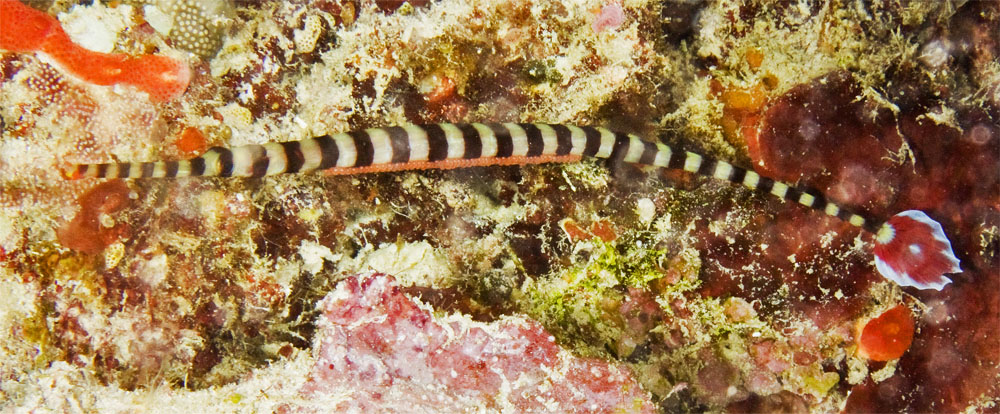
Doryrhamphus dactyliophorus
FAMILY
Syngnathidae
TAXONOMY
Syngnathus dactyliophorus Bleeker, 1853, Indonesia.
OTHER COMMON NAMES
English: Banded pipefish.
PHYSICAL CHARACTERISTICS
A very slender species, with both head and body on the same
plane. Snout very slender, about one-eighth of the total length,
with small upturned terminal mouth. Eyes round and relatively
long. Single posterior dorsal fin, with 20–26 rays; small anal fin
with four rays. Body has 15–17 bony rings, and tail has 18–22
bony rings. Caudal fin is round when expanded. Coloration
composed of alternating black to reddish and yellow bars; caudal
fin is white with a red circle. Reaches some 7.1 in (18 cm)
in length.
DISTRIBUTION
This species is present throughout much of the Indo-West Pacific,
in the Red Sea and East Africa to Samoa, and throughout
Micronesia.
HABITAT
Inhabits a wide variety of coastal habitats, such as coral reefs,
tide pools, lagoons, estuaries, sea grass meadows, and outer
reef slopes. Frequently found in crevices and sheltered areas.
BEHAVIOR
A cryptic species, preferring to remain in caves or other shelters.
Commonly seen in pairs, but occasionally large groups are
formed. Young are pelagic and transparent (up to about 1.2 in,
or 30 mm) and attain adult coloration only later, when they
settle into a more benthic lifestyle.
FEEDING ECOLOGY AND DIET
Eats small crustaceans and may even clean larger fishes, such as
morays, of small parasites. Consumed by larger fishes.
REPRODUCTIVE BIOLOGY
Males carry the eggs along their trunks ventrally. The eggs are
small and spherical and reddish when fresh. The eggs are fertilized
upon deposition on the male and hatch after a few
weeks. Juveniles often are found in rock pools but typically are
pelagic.
CONSERVATION STATUS
Listed as Data Deficient by the IUCN.
SIGNIFICANCE TO HUMANS
A popular aquarium species, which has been reared in
captivity.
Other popular Animals
Photo Gallery of - Ringed pipefish





 Animalia Life
Animalia Life